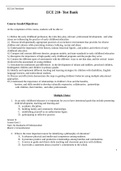Exam (elaborations)
ECE 210 Test Bank/ECE 210 Bloom Test Bank/Early Childhood Education Bloom's Test Bank
- Course
- Institution
ECE 210 Test Bank 1. As an early childhood educator it is important for you to have intentional goals that include promoting child development, teaching and learning and A. academic discipline. B. building family and community relationships. C. establishing yourself as an authoritarian figure...
[Show more]



